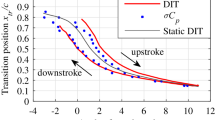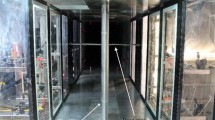Abstract
This paper presents an analysis of the differential infrared thermography (DIT) technique, a contactless method of measuring the unsteady movement of the boundary layer transition position on an unprepared surface. DIT has been shown to measure boundary layer transition positions which correlate well with those from other measurement methods. In this paper unsteady aerodynamics from a 2D URANS solution are used and the resulting wall temperatures computed. It is shown that the peak of the temperature difference signal correlates well with the boundary layer transition position, but that the start and end of boundary layer transition cannot be extracted. A small systematic time-lag cannot be reduced by using different surface materials, but the signal strength can be improved by reducing the heat capacity and heat transfer of the surface layer, for example by using a thin plastic coating. Reducing the image time separation used to produce the difference images reduces the time-lag and also the signal level, thus the optimum is when the signal to noise ratio is at the minimum which can be evaluated.

From Uenal and Grieb (2013)

From Richter et al. (2016)

From Raffel et al. (2015)

From Raffel et al. (2015)




















Similar content being viewed by others
Abbreviations
- \(\alpha \) :
-
Instantaneous angle of attack (\(^\circ \))
- \(\alpha _0\) :
-
Mean angle of attack (\(^\circ \))
- \(\alpha _1\) :
-
Pitching amplitude (\(^\circ \))
- \(a_d\) :
-
Thermal diffusivity (m\(^2\)/s)
- c :
-
Airfoil chord length (m)
- \(C_\mathrm{f}\) :
-
Skin friction coefficient
- \(C_\mathrm{p}\) :
-
Pressure coefficient
- \(\sigma C_\mathrm{p}\) :
-
Standard deviation in \(C_\mathrm{p}\)
- C :
-
Specific heat capacity (J/kg/K)
- \(\Delta T\) :
-
Temperature difference between two times (K)
- \(\epsilon \) :
-
Emissivity
- f :
-
Pitching frequency (Hz)
- \(f_\mathrm{i}\) :
-
Image time separation (acquisition) frequency (Hz)
- \(f_0\) :
-
Focal length (m)
- \(f\times t\) :
-
Normalised period time
- \(H_\mathrm{L}\) :
-
Lamp heat flux (W/m\(^2\))
- \(k_\mathrm{v}\) :
-
Thermal conductivity vertically (W/m/K)
- \(k_\mathrm{h}\) :
-
Thermal conductivity horizontally (W/m/K)
- M :
-
Mach number
- N :
-
Boundary value for the transition code
- \(\dot{q}\) :
-
Heat flux (W)
- \(\rho \) :
-
density (kg/m\(^3\))
- Re :
-
Reynolds number
- t :
-
Time (s)
- T :
-
Wall temperature (K)
- \(T_\mathrm{r}\) :
-
Flow recovery temperature (K)
- \(\mathrm{{Tu}}\) :
-
Freestream turbulence level
- v :
-
Local flow velocity (m/s)
- x :
-
Coordinate in the flow direction (m)
- y :
-
Coordinate in breadth (m)
- z :
-
Coordinate in depth (vertical) (m)
References
Astarita T, Cardone G (2000) Thermofluidynamic analysis of the flow in a sharp 180 degrees turn channel. Exp Therm Fluid Sci 20(3–4):188–200
Bouchardy A-M, Durand G, Gauffre G (1983) Processing of infrared thermal images for aerodynamic research. Appl Digit Image Process 397:304–309
Carlomagno GM, Cardone G (2010) Infrared thermography for convective heat transfer measurements. Exp Fluids 49(6):1187–1218
Døssing M (2008) High frequency microphone measurements for transition detection on airfoils. Risø-R-1645(EN)
Du Z, Selig MS (2000) The effect of rotation on the boundary layer of a wind turbine blade. Renew Energy 20(2):167–181
Eder C (2016) Analyse der Differenzinfrarotthermographie (Engl: Analysis of differential infrared thermography). Masters thesis, University of the Bundeswehr, Munich, August 2016
Gardner AD, Richter K (2015) Boundary layer transition determination for periodic and static flows using phase-averaged pressure data. Exp Fluids. doi:10.1007/s00348-015-1992-9
Gardner AD, Wolf CC, Raffel M (2016) A new method of dynamic and static stall detection using infrared thermography. Exp Fluids 57(9):2016. doi:10.1007/s00348-016-2235-4
Gartenberg E, Roberts AS Jr (1992) Twenty-five years of aerodynamic research with infrared imaging. J Aircr 29(2):161–171
Heister CC (2013) Numerical investigation of laminar-turbulent transition mechanisms for helicopter rotors in forward flight. In: American helicopter society 69th annual forum, Phoenix, Arizona, May 21–23, 2013
Krumbein A, Krimmelbein N, Schrauf G (2009a) Automatic transition prediction in hybrid flow solver, part 1: methodology and sensitivities. J Aircr. doi:10.2514/1.39736
Krumbein A, Krimmelbein N, Schrauf G (2009) Automatic transition prediction in hybrid flow solver, part 2: practical application. J Aircr. doi:10.2514/1.39738
Langtry R, Gola J, Menter F (2006) Predicting 2D airfoil and 3D wind turbine rotor performance using a transition model for general CFD codes. In: 44th AIAA aerospace sciences meeting and exhibit, p 395
Lanzafame R, Mauro S, Messina M (2013) Wind turbine CFD modeling using a correlation-based transitional model. Renew Energy 52:31–39
Mack LM (1977) Transition prediction and linear stability theory. In: AGARD Conf. Proc. no 224, Paris, 1977 (also JPL Publication 77-15, 1977)
Nitsche W, Brunn A (2006) Strömungsmesstechnik (Engl. Flow measurement techniques). Springer, Berlin. ISBN: 978-3540209904
Quast A (1987) Detection of transition by infrared image technique. In: 12th international congress on instrumentation in aerospace simulation facilities (ICIASF 87), Williamsburg, VA, 22–25 June 1987, pp 125–134
Richards EJ, Burstall FH (1945) The “China Clay” method of indicating transition. ARC R&M, No. 2126, HM Stationery. Office 19:1945
Richter K, Le Pape A, Knopp T, Costes M, Gleize V, Gardner AD (2011) Improved two-dimensional dynamic stall prediction with structured and hybrid numerical methods. J Am Helicopter Soc. doi:10.4050/JAHS.56.042007
Richter K, Koch S, Gardner AD, Mai H, Klein A, Rohardt C-H (2014) Experimental investigation of unsteady transition on a pitching rotor blade airfoil. J Am Helicopter Soc 59(1):2014. doi:10.4050/JAHS.59.012001
Richter K, Schülein S (2014) Boundary-layer transition measurements on hovering helicopter rotors by infrared thermography. Exp Fluids. doi:10.1007/s00348-014-1755-z
Richter K, Wolf CC, Gardner AD, Merz CB (2016) Detection of unsteady boundary layer transition using three experimental methods. In: 54th AIAA aerospace sciences meeting, San Diego (CA), USA, 4–8 January 2016, AIAA-2016-1072
Raffel M, de Gregorio F, de Groot K, Schneider O, Gibertini G, Seraudie A (2011) On the generation of a helicopter aerodynamic database. Aeronaut J 115(1164):103–112. doi:10.2514/1.J053235
Raffel M, Merz CB (2014) Differential infrared thermography for unsteady boundary-layer transition measurements. AIAA J 52(9):2090–2093. doi:10.2514/1.J053235
Raffel M, Merz CB, Schwermer T, Richter K (2015) Differential infrared thermography for boundary layer transition detection on pitching rotor blade models. Exp Fluids. doi:10.1007/s00348-015-1905-y
Saric et al (1994) Progress in transition modelling. AGARD-R-793
Schrauf G (1998) COCO: a program to compute velocity and temperature profiles for local and nonlocal stability analysis of compressible, conical boundary layers with suction. Center of Applied Space Technology and Microgravity Technical Rept., Nov 1998
Schrauf G (2006) LILO 2.1 user’s guide and tutorial. Geza Schrauf Stability Computations Tech. Rept. 6 (originally issued Sept. 2004, modified for Ver. 2.1 July 2006)
Schülein E (2014) Optical method for skin-friction measurements on fast-rotating blades. Exp Fluids. doi:10.1007/s00348-014-1672-1
Schultz DL, Jones TV (1973) Heat-transfer measurements in short-duration hypersonic facilities. AGARDograph 165
Schwamborn D, Gardner AD, von Geyr H, Krumbein A, Lüdeke H, Stürmer A (2008) Development of the TAU-code for aerospace applications. In: 50th NAL INCAST (international conference on aerospace science and technology), Bangalore, India, June 26–28, 2008
Simon B, Filius A, Tropea C, Grundmann S (2016) IR thermography for dynamic detection of laminar-turbulent transition. Exp Fluids. doi:10.1007/s00348-016-2178-9
Spalart PR, Allmaras SR, (1992) A one-equation turbulence model for aerodynamic flows, AIAA 1992-0439. In: AIAA 30th aerospace sciences meeting and exhibit, Reno, NV, January 6–9, 1992
Thomann H, Frisk B (1967) Measurement of heat transfer with an infrared camera. Int J Heat Mass Transf 11:819–826
Uenal E, Grieb H (2013) stall and transition on elastic rotor blades T1.1 DSA-9A static validation of wind tunnel model. Ferchau engineering report, 2013
Velkoff HR, Blaser DA, Jones KM (1971) Boundary-layer discontinuity on a helicopter rotor blade in hovering. J Aircr 8(2):101–107. doi:10.2514/3.4423610.2514/3.45910
Acknowledgements
This work was done within the DLR projects FAST-Rescue and STELAR.
Author information
Authors and Affiliations
Corresponding author
Rights and permissions
About this article
Cite this article
Gardner, A.D., Eder, C., Wolf, C.C. et al. Analysis of differential infrared thermography for boundary layer transition detection. Exp Fluids 58, 122 (2017). https://doi.org/10.1007/s00348-017-2405-z
Received:
Revised:
Accepted:
Published:
DOI: https://doi.org/10.1007/s00348-017-2405-z




